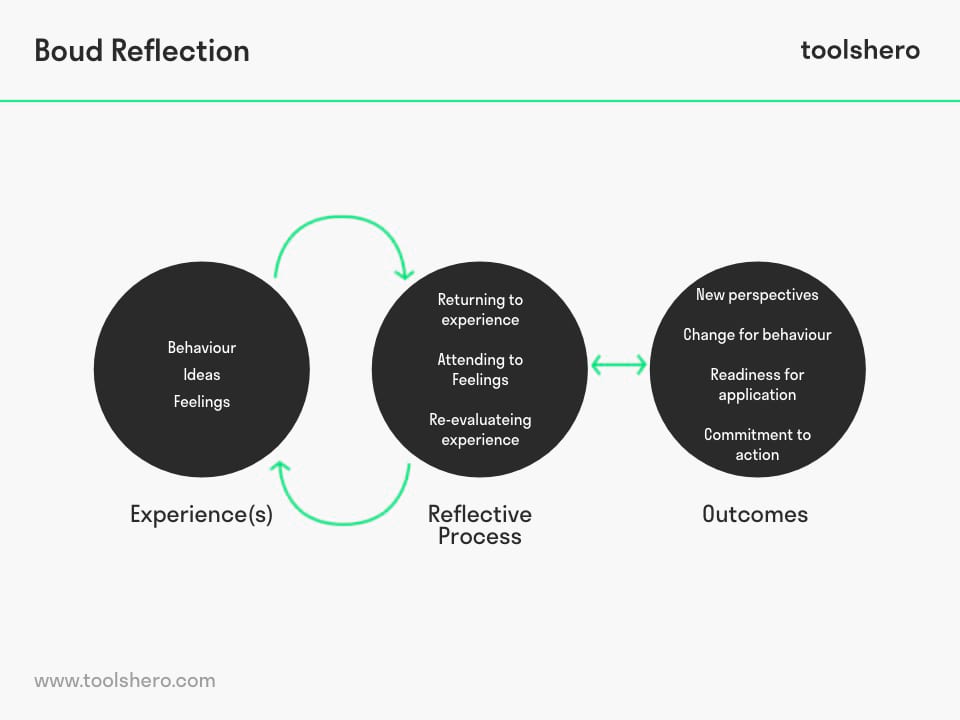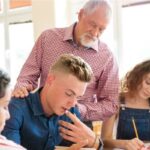Boud Reflection Model: Theory and Example

Boud Reflection Model: this article explains the Boud Reflection Model, also called Reflection of Learning, developed by David Boud, Rosemary Keogh and David Walker in a practical way. Next to what it is, this article also highlights the identifying learning experiences, the advantages, the phases of reflective learning and further elaboration on the stages of the Boud Reflection Model. After reading, you will understand the basic concepts of this reflective cycle learning tool for professionals who wish to self-assess. Enjoy reading!
What is the Boud Reflection Model?
The Boud Reflection Model is a reflective learning model by David Boud, Rosemary Keogh and David Walker (1985), which focuses on learning by reflecting on one’s practice.
A reflective practitioner of any kind can reflect on their own practice to better understand their activities and their background in order to improve what they do with their work responsibilities.
The emotions of a person related to the experiences at work are based on the reflective self-analysis that the model provides where the work experience must be thought about, reflected upon and evaluated in order to stimulate the personal improvements of each person and lead to learning.
Previously it was essential and considered better that educational learning models were about passing on information from the teacher or educator to the students.
However, the development of understanding what is known and putting it into practice results in awareness (reflection on it), which was less valued.
This reflective cycle model reminds us of the importance of our own experiences in the face of what we know and how we execute what we know from our emotion and intelligence.
What we are told, explained and conveyed goes further when each person appropriates the message they have learned and how this transforms them and makes sense of their environment and individual goals. Doing things not just because someone else told us to, but because we make sense of it.
Why is reflection so important in learning?
The experience based on learning goes beyond the actions that the professional does with “his duty at work” “his professional responsibilities”.
Reflection is vital in learning because it connects the emotions a person feels when exercising his or her work duties where the experience of what he or she lives every day is connected to his or her actions, including his or her style of exercising decisions that are his or her own or that include his or her team.
In order to be able to fulfil the necessary responsibilities it is common that one must have previous knowledge of what one is doing, either because it was learned for years or also because it was learned in a short time.
The Boud Reflection Model leads us to analyse our practices as if we were an external person who observes and is neutral with opinions and concepts without fear of criticism.
Identifying learning experiences
More than the information we receive over the years, with our environment and with the experiences we live, sometimes we do not stop to reflect and identify what we learn with the most basic details of our existence that make our personal intellect to develop professionally in an easier and more enjoyable way.
When identifying learning experiences, we should ask the following questions How do we learn from our experiences? What are the key ideas of learning in our experiences? How do we reflect on our learning experiences? How does the context in which we operate connect to learning? With these questions we can further identify the different elements of the Boud Reflection Model.
It is also necessary to emphasize that the Reflective Cycle Learning Theory is based on the experiences of individuals according to their experiences and learning, but Boud focuses specifically on the experiences of adults and how they evaluate themselves in their professional practices.
Look at the following visualisation of the Boud Reflection Model.

Figure 1 – Boud Reflective Model (Boud, Keogh and Walker, 1985)
According to the person’s intellect, this is connected to their activities which are linked to exploring different experiences in which the person learns from them and gives an appreciation.
During the experience a person has, the experience is connected to behaviours, ideas and feelings. When the experience starts, there will be a mental reflection on what was lived in that particular experience.
It is important to focus on several points: positive feelings and negative feelings in order to review what is good and bad. Once these points are established, the negative feelings should be eliminated and the positive feelings should be used in reflection for future experiences.
Advantages of the Boud reflective cycle model
There are several advantages over this model of Boud reflection and the results it can present. This model can influence the transformation of a person’s thoughts in their work.
It can develop other kinds of perspectives that were sometimes subject to negative thoughts. More commitment at work, being more aware of what you do and why you do it, can lead to success in work practices.
Something else that this model offers is the focus on the emotions, it has always been said that one should focus on the logical without being influenced by the emotions, however, in this Boud model the emotions are important because it allows the person to listen to what he feels at the moment of his work practice, his intuition is vital.
In this way they can separate the useful and useless feelings that are part of their work actions.
This could improve professional practices in the future as they are able to control emotions and use them to their advantage in the performance of professional activities.
The phases of reflective learning
For the Reflective Boud Model it is important to connect the learning improvements connected to the learning experiences and that the learners are able to do it and understand it. With this the phases of reflective learning will help.
This is how a reflective activity plan for the learning process becomes:
- Return to the experience
- Connecting emotions or feelings
- Evaluating the experience
These three phases are important for the reflective cycle process:
1. Return to experience
Returning to experience is the basis of learning. It is necessary to return to review what happened, what you lived and experienced for further learning. Experiences should not be left behind and forgotten. It is important to return mentally and review what happened. This is the first step.
2. Attending to feelings
This phase has two aspects: using positive feelings and removing the negative feelings that are obstructing. Using positive feelings focuses on positive feelings about the learning experience which are subject to reflection.
This creates an awareness of the environment in which it is taking place and seeing the benefits that are being generated from that experience derived from the processes of the events that occurred.
With the necessary attention to feelings as part of the return experience, people (learners) focus on the feelings and emotions that are present. These feelings can enhance reflection and learning. This will generate in the professional environment the motivation and desire to continue learning.
3. Re-evaluating experience
Re-evaluation of the experience is to take up the event and the attention of the thoughts and feelings associated with this event. For this, four elements of re-evaluation are necessary and the person (student) must take them into account:
- Association: relate new information to what one already has.
- Integration: to look for the relationships that the new information has with the old one.
- Validation: determine the authenticity for the learner of the ideas and feelings that have resulted.
- Ownership: making one’s own knowledge an essential part of operating the work.
The above are not considered as stages since they can be presented in isolation in the apprentice’s experience, thus promoting critical reflection to challenge old ways of learning.
Further elaboration on the stages of the Boud Reflection Model
Stage 1: Returning to the experience
One of the most used activities in the return of the experience in the reflection is the collection of the activities that were taken in the experience. Reflecting on what really happened in the event and what reactions occurred to all the elements.
Whenever we review a memory, in this case an experience, we rely on the chronological form to align the memory more clearly and precisely. With this we can detail situations and moments that we overlooked before our eyes at the time we lived the experience.
Recapturing the experience in our mind is vital in order to transform the learning.
Example: an international business student goes on a study trip with his colleagues to Luxembourg to study economic development as the Gross Domestic Product per capita is one of the highest in the world according to the World Bank.
At the end of the trip the student needs to make a report on what he or she has learned from the trip. In order to do this the student returns to his/her notebook to be able to reconstruct the events of the past (his/her travel experience/day by day).
This raises questions such as: Why did I write this? What was happening when I observed this? What emotions did I feel? With these collections you can write your report, using your experience to extract the most important things.
With this return to experience in a logical and organised way you can connect the events that happened at the event with different personal perspectives of the learner. If there were challenges in that experience the apprentice can recapitulate what happened, developing mental agility and learning.
Stage 2: Attending to feelings
From our emotions and feelings there is an important learning resource, however, we must know that sometimes they can be barriers, so we must choose between positive emotions and throw away the negative ones.
Depending on the circumstances of the experience, we must work on the emotional responses we have.
With the example of the international business student, this student will use the positive emotions and feelings still in his memory to connect the writing and make the appropriate report. This may be with the processes that most positively impacted him on his journey.
If we bring our positive states into our experiences we can connect cognitive learning and develop our emotional experiences.
Stage 3: Reassessing the experience
To achieve the re-evaluation of the experience, the two steps must be carried out: return to the experience and address the feelings by examining with the four elements mentioned above: association, integration, validation and appropriation.
According to our objectives and what we really want, we consciously extract what we need in order to fulfil what we want. This process will guide the learning process.
The student will be more aware of the experience in Luxembourg by recapitulating in his report what he learned, from logic to evidence of his emotions at the level of a writing (report).
Background
Learning from experience has been developing since the 1970s. Previously it was predominant to only transmit information to students in the education system, where the role of the educator was to provide knowledge and the role of the learner was only to absorb and repeat it in most cases.
This is why the reflective practice of learning was born, which many academics are looking for in the learning model apart from Boud.
Among some pedagogues, David Kolb argued for focusing on the capacity of the learner to build knowledge. Kolb’s Reflective Cycle characterised learning as a process by which each individual reflected on their experiences to build and reconstruct their understanding and skills.
There is also John Dewey who emphasised reflective thinking as an important part of experiential learning. According to him, reflective thinking began when an experience presented challenges or difficulties and so reflected on the problems presented by the experiences.
It is your turn
What do you think? Is learning possible in the face of self-evaluation of personal experiences? is it possible to put pedagogy into professional practice? do you think that one should be aware of the work processes that are done even if they are automatic and monotonous?
Share your experience and knowledge in the comments box below.
More information
- Boud, D., Keogh, R., & Walker, D. (1996). Promoting reflection in learning: A model. Boundaries of adult learning, 1, 32-56.
- Boud, D., Keogh, R., & Walker, D. (Eds.). (2013). Reflection: Turning experience into learning.
- Boud, D., & Walker, D. (1993). Barriers to reflection on experience. Using experience for learning, 73-86
- Boud, D. (1999). Avoiding the traps: Seeking good practice in the use of self assessment and reflection in professional courses. Social Work Education, 18(2), 121-132
How to cite this article:
Ospina Avendano, D. (2020). Boud Reflection Model. Retrieved [insert date] from Toolshero: https://www.toolshero.com/personal-development/boud-reflection-model/
Original publication date: 12/04/2020 | Last update: 11/21/2023
Add a link to this page on your website:
<a href=”https://www.toolshero.com/personal-development/boud-reflection-model/”>Toolshero: Boud Reflection Model</a>












